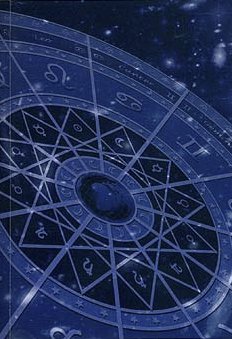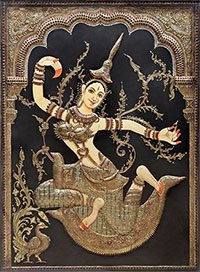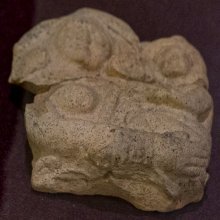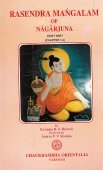Shishu, Śiśu: 24 definitions
Introduction:
Shishu means something in Hinduism, Sanskrit, Marathi, Jainism, Prakrit, Hindi, biology, Tamil. If you want to know the exact meaning, history, etymology or English translation of this term then check out the descriptions on this page. Add your comment or reference to a book if you want to contribute to this summary article.
The Sanskrit term Śiśu can be transliterated into English as Sisu or Shishu, using the IAST transliteration scheme (?).
Images (photo gallery)
In Hinduism
Purana and Itihasa (epic history)
Source: archive.org: Puranic EncyclopediaŚiśu (शिशु).—A son born to the Saptamātṛs due to the blessing of Subrahmaṇya. The eyes of the child were blood-red. It was called Vīrāṣṭaka as well. (Vana Parva, Chapter 228, Verse 11).
Source: archive.org: Shiva Purana - English TranslationŚiśu (शिशु) refers to a “child”, according to the Śivapurāṇa 2.3.10.—Accordingly, as Brahmā narrated to Nārada:—“[...] Thus Śiva remained for a long time eliminating the three attributes, and unaffected by aberrations. The lord Himself, the controller of illusion remained in the state of the Supreme Brahman. Then He gave up trance. Many years elapsed. What happened thereafter, I shall now recount to you. The drops of sweat caused by exhaustion fell on the Earth from the lord’s forehead and took the shape of a child [i.e., śiśu] immediately. [...]”.
Source: Cologne Digital Sanskrit Dictionaries: The Purana Index1a) Śiśu (शिशु).—A son of Balarāma.*
- * Brahmāṇḍa-purāṇa III. 71. 166.
1b) A son of Sāraṇa.*
- * Vāyu-purāṇa 96. 164; Viṣṇu-purāṇa IV. 15. 21.

The Purana (पुराण, purāṇas) refers to Sanskrit literature preserving ancient India’s vast cultural history, including historical legends, religious ceremonies, various arts and sciences. The eighteen mahapuranas total over 400,000 shlokas (metrical couplets) and date to at least several centuries BCE.
Shaktism (Shakta philosophy)
Source: Google Books: ManthanabhairavatantramŚiśu (शिशु) refers to a “small child”, according to the Devīpañcaśatikā verse 2.74-79.—Accordingly: “One should draw the supreme goddess there. She is Śuṣkā and, auspicious, her face is emaciated. [...] She is Aghorā and her teeth are fearsome. She makes the great (magical) sound ‘phet’. Her hair is tied up (on the top of her head) and, auspicious, she has three eyes and holds a large (sacrificial) vessel. Her breasts are shrivelled up and her belly is very thin. She holds the ear of a small child [i.e., śiśu-karṇa-avalambinī]. Ferocious, she is adorned with a garland of severed heads and ornaments made of great snakes. Having drawn her in this form, one should worship the Mother (of the letters) there”.

Shakta (शाक्त, śākta) or Shaktism (śāktism) represents a tradition of Hinduism where the Goddess (Devi) is revered and worshipped. Shakta literature includes a range of scriptures, including various Agamas and Tantras, although its roots may be traced back to the Vedas.
Jyotisha (astronomy and astrology)
Source: Wisdom Library: Brihat Samhita by VarahamihiraŚiśu (शिशु) refers to “infants”, according to the Bṛhatsaṃhitā (chapter 16) (“On the planets—graha-bhaktiyoga”), an encyclopedic Sanskrit work written by Varāhamihira mainly focusing on the science of ancient Indian astronomy astronomy (Jyotiṣa).—Accordingly, “[...] Mercury also presides over painters, grammarians, mathematicians, physicians, sculptors, spies, jugglers, infants (śiśu), poets, rogues, tale-bearers, black-magicians, messengers, eunuchs, buffoons, sorcerers and conjurers; over sentinels, dancers and dancing masters; over ghee, gingelly and other oils; over seeds, over bitter flavour, over observers of religious ceremonies, over chemists and mules”.

Jyotisha (ज्योतिष, jyotiṣa or jyotish) refers to ‘astronomy’ or “Vedic astrology” and represents the fifth of the six Vedangas (additional sciences to be studied along with the Vedas). Jyotisha concerns itself with the study and prediction of the movements of celestial bodies, in order to calculate the auspicious time for rituals and ceremonies.
Ayurveda (science of life)
Toxicology (Study and Treatment of poison)
Source: Shodhganga: Kasyapa Samhita—Text on Visha ChikitsaŚiśu (शिशु) is the name of an ingredient used in the treatment of Maṇḍalī-snake-bites, according to the Kāśyapa Saṃhitā: an ancient Sanskrit text from the Pāñcarātra tradition dealing with both Tantra and Viṣacikitsā—an important topic from Āyurveda which deals with the study of Toxicology (Viṣavidyā or Sarpavidyā).—A number of different permutation and combination of herbs are prescribed as Lepa and Pāna for removing the poison of Maṇḍalī snakes.—According to the Kāśyapasaṃhitā verse 9.78ab: “Powder of Turmeric, stem of Alarka, Banana, Tumbī, asafoetida, Munidruma/Agastyavṛkṣa, Śiśo (śiśu), Nīlī, stem of Guñjā mixed with fresh water cures Maṇḍalīviṣa”.

Āyurveda (आयुर्वेद, ayurveda) is a branch of Indian science dealing with medicine, herbalism, taxology, anatomy, surgery, alchemy and related topics. Traditional practice of Āyurveda in ancient India dates back to at least the first millenium BC. Literature is commonly written in Sanskrit using various poetic metres.
Sports, Arts and Entertainment (wordly enjoyments)
Source: archive.org: Syainika Sastra of Rudradeva with English Translation (art)Śiśu (शिशु) refers to a “young gazelle” (which were often the victim of hunters), according to the Śyainika-śāstra: a Sanskrit treatise dealing with the divisions and benefits of Hunting and Hawking, written by Rājā Rudradeva (or Candradeva) in possibly the 13th century.—Accordingly, [while discussing the outlines of hawking]: “[...] Caraka, when it seizes a young (śiśu) gazelle [hāriṇaṃ śiśumādāya] and eats its limbs and entrails, produces irresistibly a loathing. Kecuka and other birds, afraid of the swiftness of the wings of Ṭonā and others, hiding themselves motionless in bushes, produce the emotion of fear”.

This section covers the skills and profiencies of the Kalas (“performing arts”) and Shastras (“sciences”) involving ancient Indian traditions of sports, games, arts, entertainment, love-making and other means of wordly enjoyments. Traditionally these topics were dealt with in Sanskrit treatises explaing the philosophy and the justification of enjoying the pleasures of the senses.
Biology (plants and animals)
Source: Wisdom Library: Local Names of Plants and DrugsSisu [সিসু] in the Assamese language is the name of a plant identified with Dalbergia sissoo Roxb. ex DC. from the Fabaceae (Pea) family having the following synonyms: Dalbergia pendula, Pterocarpus sissoo. For the possible medicinal usage of sisu, you can check this page for potential sources and references, although be aware that any some or none of the side-effects may not be mentioned here, wether they be harmful or beneficial to health.
Source: Google Books: CRC World Dictionary (Regional names)1) Sisu in English is the name of a plant defined with Dalbergia sissoo in various botanical sources. This page contains potential references in Ayurveda, modern medicine, and other folk traditions or local practices It has the synonym Amerimnon sissoo Kuntze (among others).
2) Sisu in India is also identified with Citrus aurantium It has the synonym Citrus amara Link (etc.).
3) Sisu is also identified with Dalbergia latifolia It has the synonym Amerimnon latifolium (Roxb.) Kuntze, nom. illeg. (etc.).
Example references for further research on medicinal uses or toxicity (see latin names for full list):
· Journal of Wuhan Botanical Research (1990)
· Flora Indica; or, descriptions of Indian Plants (1832)
· Nova Genera et Species Plantarum (1823)
· Revisio Generum Plantarum (1891)
· Annals of the Missouri Botanical Garden (1981)
· Species Plantarum (1753)
If you are looking for specific details regarding Sisu, for example health benefits, chemical composition, pregnancy safety, side effects, diet and recipes, extract dosage, have a look at these references.

This sections includes definitions from the five kingdoms of living things: Animals, Plants, Fungi, Protists and Monera. It will include both the official binomial nomenclature (scientific names usually in Latin) as well as regional spellings and variants.
Languages of India and abroad
Marathi-English dictionary
Source: DDSA: The Molesworth Marathi and English Dictionaryśiśu (शिशु).—m S A young one of man or an animal in general; a child, a calf, a pup, a cub, a whelp. Applied in poetry also to the young one of a fish. Ex. asō macchaśiśūnēṃ ugaḷūna || āṇūna ṭhēvilā pūrvasthaḷīṃ ||.
Source: DDSA: The Aryabhusan school dictionary, Marathi-Englishśiśu (शिशु).—m A child. A calf; a pup.
Marathi is an Indo-European language having over 70 million native speakers people in (predominantly) Maharashtra India. Marathi, like many other Indo-Aryan languages, evolved from early forms of Prakrit, which itself is a subset of Sanskrit, one of the most ancient languages of the world.
Sanskrit dictionary
Source: DDSA: The practical Sanskrit-English dictionaryŚiśu (शिशु).—[śo-ku sanvadbhāvaḥ dvitvam cf. Uṇādi-sūtra 1.2]
1) A child, an infant; शिशुर्वा शिष्या वा (śiśurvā śiṣyā vā) Uttararāmacarita 4.11.
2) The young of any animal (as a calf, puppy, fawn &c.); नष्टाशङ्का हरिणशिशवो मन्दमन्दं चरन्ति (naṣṭāśaṅkā hariṇaśiśavo mandamandaṃ caranti) Ś.1.15;7.14,18.
3) A boy under eight or sixteen years of age.
4) A pupil, scholar.
5) An elephant in the sixth year; Mātaṅga L.5.8.
Derivable forms: śiśuḥ (शिशुः).
Source: Cologne Digital Sanskrit Dictionaries: Shabda-Sagara Sanskrit-English DictionaryŚiśu (शिशु).—m.
(-śuḥ) 1. The young of man or any animal, a child, a calf, &c. 2. A pupil, a scholar. 3. A boy under eight years of age. 4. A lad or boy not more than sixteen. E. śo to destroy, Unadi aff. u, and the root repeated, with i substituted for the semivowel to which the radical vowel is changed in its inflections.
Source: Cologne Digital Sanskrit Dictionaries: Benfey Sanskrit-English DictionaryŚiśu (शिशु).—i. e. reduplic. śvi, m. 1. The young of man or any animal, [Vikramorvaśī, (ed. Bollensen.)] [distich] 121; [Pañcatantra] 160, 4; a child, [Pañcatantra] i. [distich] 241; a calf, [Pañcatantra] 182, 12; a pup, etc. 2. A boy. 3. A pupil.
Source: Cologne Digital Sanskrit Dictionaries: Cappeller Sanskrit-English DictionaryŚiśu (शिशु).—[masculine] young, child.
Source: Cologne Digital Sanskrit Dictionaries: Aufrecht Catalogus CatalogorumŚiśu (शिशु) as mentioned in Aufrecht’s Catalogus Catalogorum:—son of Vaṭeśa: Jātakasāra.
Source: Cologne Digital Sanskrit Dictionaries: Monier-Williams Sanskrit-English Dictionary1) Śiśu (शिशु):—m. ([from] √1. śū = śvi) a child, infant, the young of any animal (as a calf, puppy etc.; also applied to young plants, and to the recently risen sun; often ifc.), [Ṛg-veda] etc. etc.
2) a boy under eight years of age, [Horace H. Wilson]
3) a lad under sixteen, [ib.]
4) a pupil, scholar, [ib.]
5) Name of Skanda, [Mahābhārata; Rāmāyaṇa] (cf. kumāra)
6) of a descendant of Aṅgiras (author of [Ṛg-veda ix, 112]), [Anukramaṇikā]
7) of a son of Sāraṇa, [Viṣṇu-purāṇa]
8) of a king, [Buddhist literature]
9) [according to] to some also = śiśna, ‘membrum virile’
10) mfn. young, infantine, [cf. Lexicographers, esp. such as amarasiṃha, halāyudha, hemacandra, etc.]
Source: Cologne Digital Sanskrit Dictionaries: Yates Sanskrit-English DictionaryŚiśu (शिशु):—(śuḥ) 2. m. The young of man or any animal; an infant, a child.
Source: DDSA: Paia-sadda-mahannavo; a comprehensive Prakrit Hindi dictionary (S)Śiśu (शिशु) in the Sanskrit language is related to the Prakrit word: Sisu.
[Sanskrit to German]
Sanskrit, also spelled संस्कृतम् (saṃskṛtam), is an ancient language of India commonly seen as the grandmother of the Indo-European language family (even English!). Closely allied with Prakrit and Pali, Sanskrit is more exhaustive in both grammar and terms and has the most extensive collection of literature in the world, greatly surpassing its sister-languages Greek and Latin.
Hindi dictionary
Source: DDSA: A practical Hindi-English dictionaryŚiśu (शिशु):—(nm) an infant; a baby; child; -[kalyāṇa] child welfare; -[kalyāṇa keṃndra] child welfare centre; ~[gṛha] a nursery; ~[ghāta/ ~ghātaka] infanticide; -[pakṣāghāta] infantile paralysis; ~[pālana] rearing of children; ~[pālana-gṛha] a nursery; -[bali] child sacrifice; ~[hatyā] infanticide; -[hatyārā] infanticide.
...
Prakrit-English dictionary
Source: DDSA: Paia-sadda-mahannavo; a comprehensive Prakrit Hindi dictionarySisu (सिसु) in the Prakrit language is related to the Sanskrit word: Śiśu.
Prakrit is an ancient language closely associated with both Pali and Sanskrit. Jain literature is often composed in this language or sub-dialects, such as the Agamas and their commentaries which are written in Ardhamagadhi and Maharashtri Prakrit. The earliest extant texts can be dated to as early as the 4th century BCE although core portions might be older.
Kannada-English dictionary
Source: Alar: Kannada-English corpusŚiśu (ಶಿಶು):—
1) [noun] a very young child; a baby; an infant.
2) [noun] a young of any animal.
3) [noun] a student, pupil (as related to his teacher).
--- OR ---
Sisu (ಸಿಸು):—
1) [noun] (correctly, ಶಿಶು [shishu])1. a very young child; a baby; an infant.
2) [noun] a young boy or girl.
--- OR ---
Sīsu (ಸೀಸು):—[noun] = ಸೀಸ [sisa]3.
Kannada is a Dravidian language (as opposed to the Indo-European language family) mainly spoken in the southwestern region of India.
See also (Relevant definitions)
Starts with (+72): Shimshumaraka, Shimshupa, Shishu-kalyana-kendra, Shishubhaishyajja, Shishubhava, Shishubhupati, Shishubodha, Shishubodhana, Shishubodhini, Shishucandrayana, Shishuchandrayana, Shishudeshya, Shishudhani, Shishugandha, Shishughataka, Shishugita, Shishuharinadrish, Shishuhatya, Shishuhatye, Shishuhita.
Ends with: Anushishu, Ashishishu, Ashishu, Bhujamgashishu, Bhujangashishu, Devashishu, Dikshishu, Dravidashishu, Hashishu, Hayashishu, Kadushishu, Mumushishu, Paricikshishu, Pranalashishu, Rirakshishu, Shashakashishu, Shashishashishu, Simhashishu, Vivarshishu.
Full-text (+151): Kushimshapa, Agurushimshapa, Shishukranda, Shishuta, Shimshapa, Shishuvahaka, Shisava, Shishumara, Apuccha, Picchitika, Dhumrika, Shamsapa, Yugmapatrika, Gurushimshapa, Bhasmagarbha, Shishugandha, Shishuvahyaka, Shaishava, Shishunaman, Shishupalaka.
Relevant text
Search found 41 books and stories containing Shishu, Śiśu, Sisu, Sīsu; (plurals include: Shishus, Śiśus, Sisus, Sīsus). You can also click to the full overview containing English textual excerpts. Below are direct links for the most relevant articles:
Garga Samhita (English) (by Danavir Goswami)
Verse 1.19.25 < [Chapter 19 - Breaking of the Two Arjuna Trees]
Verse 1.11.48 < [Chapter 11 - Description of Śrī Kṛṣṇacandra’s Birth]
Verse 1.10.35 < [Chapter 10 - Description of the Birth of Lord Balarāma]
Rig Veda (translation and commentary) (by H. H. Wilson)
Sahitya-kaumudi by Baladeva Vidyabhushana (by Gaurapada Dāsa)
Text 10.136 < [Chapter 10 - Ornaments of Meaning]
Text 7.155 < [Chapter 7 - Literary Faults]
Text 2.8 < [Chapter 2 - The Natures of Words (śabda)]
Bhakti-rasamrta-sindhu (by Śrīla Rūpa Gosvāmī)
Verse 4.2.8 < [Part 2 - Astonishment (adbhuta-rasa)]
Verse 3.4.24 < [Part 4 - Parenthood (vātsalya-rasa)]
Verse 2.4.76 < [Part 4 - Transient Ecstatic Disturbances (vyābhicāri-bhāva)]
Mahabharata (English) (by Kisari Mohan Ganguli)
Manusmriti with the Commentary of Medhatithi (by Ganganatha Jha)
Verse 11.9-10 < [Section II - The Brāhmaṇa’s Responsibilities and Privileges regarding Sacrificial Performances]
Verse 11.219 < [Section XXIX - Description of the Expiatory Penances]
Related products

